'Tally-Ho the Skylab': The Mission to Save America's Space Station, 45 Years On (1)
By Ben Evans, on May 27th, 2018
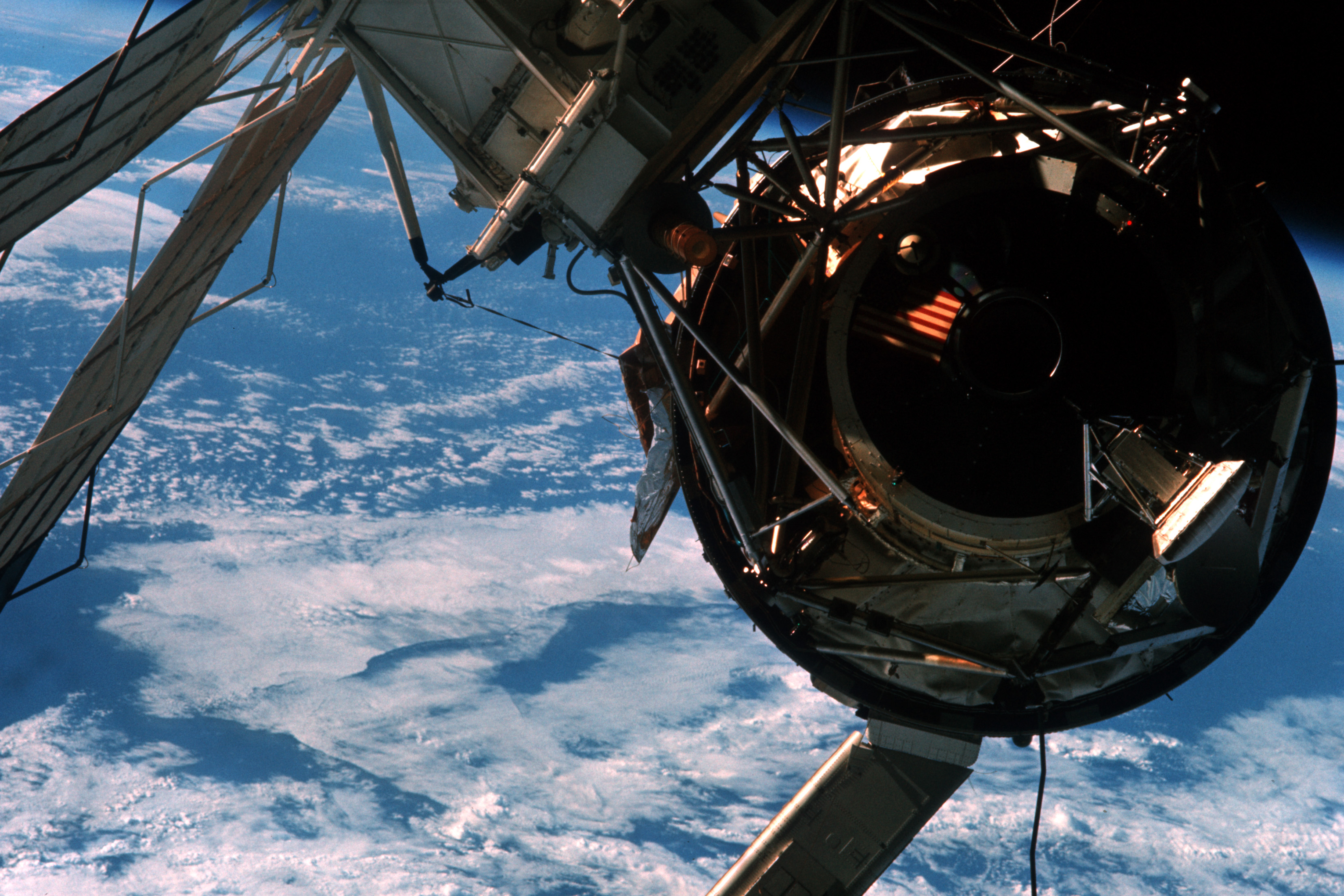 The multiple docking adaptor and Apollo Telescope Mount (top left) of Skylab, viewed from the crew of the first visiting mission. Photo Credit: NASAFour decades have now passed since one of the most dramatic reversals in fortune in American space history: the salvation of Skylab. On 14 May 1973, America’s first space station was launched into orbit atop the final Saturn V booster, but an unfortunate sequence of events led to the premature deployment of its micrometeoroid shield, which was promptly ripped away in the supersonic airstream, together with one of two solar arrays. The other solar array was so clogged with debris that it was “pinned” to the side of the station. For ten days, engineers battled to come up with a workable plan whereby Skylab’s first crew—Commander Charles “Pete” Conrad, Science Pilot Joe Kerwin and Pilot Paul Weitz—could effect a successful repair and keep the crippled station on the straight and narrow.
The multiple docking adaptor and Apollo Telescope Mount (top left) of Skylab, viewed from the crew of the first visiting mission. Photo Credit: NASAFour decades have now passed since one of the most dramatic reversals in fortune in American space history: the salvation of Skylab. On 14 May 1973, America’s first space station was launched into orbit atop the final Saturn V booster, but an unfortunate sequence of events led to the premature deployment of its micrometeoroid shield, which was promptly ripped away in the supersonic airstream, together with one of two solar arrays. The other solar array was so clogged with debris that it was “pinned” to the side of the station. For ten days, engineers battled to come up with a workable plan whereby Skylab’s first crew—Commander Charles “Pete” Conrad, Science Pilot Joe Kerwin and Pilot Paul Weitz—could effect a successful repair and keep the crippled station on the straight and narrow.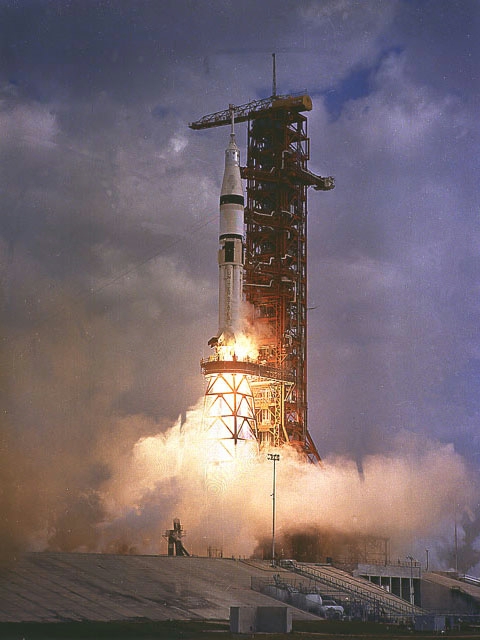 With a cry of “We can fix anything”, the first crew heads toward Skylab on 25 May 1973. Since the launch pad was originally configured for the enormous Saturn V rocket, the smaller Saturn IB required a ‘pedestal’ to raise its stages to the appropriate level for umbilicals and other utilities. Photo Credit: NASAWith their launch scheduled for the stroke of 9 a.m., the morning of 25 May was particularly peaceful for the three astronauts. “This was the least well-attended Apollo launch in history,” Joe Kerwin recalled, “because everybody had to go home and put the kids back in school. We arrived at the command module and looked inside and it was a sea of brown rope under the seats and under the brown ropes were all these different umbrellas and parasols and sails and also the equipment that we had selected to try and free up the solar panel, which was a pretty eclectic collection of aluminum poles that could be connected together, and a Southwestern Bell Telephone Company tree-lopper with brown ropes to open and close the jaws. Some of it we’d seen, some of it we hadn’t!”
With a cry of “We can fix anything”, the first crew heads toward Skylab on 25 May 1973. Since the launch pad was originally configured for the enormous Saturn V rocket, the smaller Saturn IB required a ‘pedestal’ to raise its stages to the appropriate level for umbilicals and other utilities. Photo Credit: NASAWith their launch scheduled for the stroke of 9 a.m., the morning of 25 May was particularly peaceful for the three astronauts. “This was the least well-attended Apollo launch in history,” Joe Kerwin recalled, “because everybody had to go home and put the kids back in school. We arrived at the command module and looked inside and it was a sea of brown rope under the seats and under the brown ropes were all these different umbrellas and parasols and sails and also the equipment that we had selected to try and free up the solar panel, which was a pretty eclectic collection of aluminum poles that could be connected together, and a Southwestern Bell Telephone Company tree-lopper with brown ropes to open and close the jaws. Some of it we’d seen, some of it we hadn’t!”
The astronauts were unperturbed. Indeed, as the Saturn IB cleared the tower and roared into the clear morning sky, Conrad declared that his crew could fix anything. Launch came precisely on time and kicked off an eight-hour orbital ballet to rendezvous with the crippled Skylab later that same afternoon. Little did anyone know that the first day in space for Pete Conrad and his crew would run to no less than 22 hours…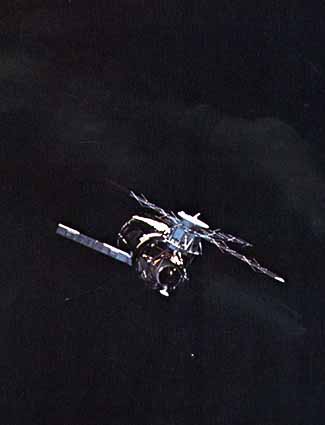 The first view of Skylab in orbit was disheartening for Pete Conrad, who had headed the astronaut office’s Skylab Branch (and been nicknamed ‘Sky King’) since 1970. One solar array was gone, the other was jammed and the lost micrometeoroid shield placed any prospect of a successful repair in jeopardy. Photo Credit: NASAConrad’s call of “Tally-ho the Skylab!” as a steadily brightening star on the horizon drew closer masked, at first, the seriousness of what the astronauts were about to face. The micrometeoroid shield was gone, as was one of the two solar arrays, whilst the second was so jammed with debris that it could not deploy properly. As Weitz took pictures, Conrad performed a flyaround inspection of the station, quickly ascertaining that the scientific airlock was not cluttered with debris, thereby making the deployment of the Johnson Space Center’s specially-conceived parasol a realistic option, and asserting his conviction that a stand-up EVA with the cable cutter should be enough to free the jammed solar array.
The first view of Skylab in orbit was disheartening for Pete Conrad, who had headed the astronaut office’s Skylab Branch (and been nicknamed ‘Sky King’) since 1970. One solar array was gone, the other was jammed and the lost micrometeoroid shield placed any prospect of a successful repair in jeopardy. Photo Credit: NASAConrad’s call of “Tally-ho the Skylab!” as a steadily brightening star on the horizon drew closer masked, at first, the seriousness of what the astronauts were about to face. The micrometeoroid shield was gone, as was one of the two solar arrays, whilst the second was so jammed with debris that it could not deploy properly. As Weitz took pictures, Conrad performed a flyaround inspection of the station, quickly ascertaining that the scientific airlock was not cluttered with debris, thereby making the deployment of the Johnson Space Center’s specially-conceived parasol a realistic option, and asserting his conviction that a stand-up EVA with the cable cutter should be enough to free the jammed solar array.
The first order of business was a “soft docking” at Skylab’s forward port at 5:56 p.m., engaging capture latches but not retracting the command module’s docking probe to ensure a firm metallic embrace. For a few minutes, the astronauts ate a quick dinner and prepared for the stand-up EVA. “A full hard dock wasn’t desirable at this point,” wrote David Hitt, Owen Garriott and Joe Kerwin in their book Homesteading Space, “because of the likelihood that they’d undock again shortly. The docking system needed to be dismantled and reset after a hard dock.” With all three men fully suited, Conrad undocked from Skylab at 6:45 p.m., depressurized the cabin, and opened the side hatch. With Kerwin hanging onto his ankles to provide stability, Weitz reached out and used modified tree loppers and a kind of “shepherd’s crook” to free the jammed array. It should have been an occasion of euphoria for Weitz, who had not been scheduled to perform an EVA at all on this mission. Unfortunately, despite his sterling efforts, it did not go well. Skylab’s precarious condition is evident in this image from Pete Conrad’s crew, revealing the tubing and wiring from the torn solar array at middle left. For several days, power came from the ‘windmill’ of arrays on the Apollo Telescope Mount (background). Photo Credit: NASAAt first, he positioned himself with his upper body poking through the hatch. Kerwin passed him three sections to assemble a 15-foot (4.5-meter) pole with the loppers at the end, whilst Conrad kept the spacecraft steady. “We had seen…that there was a piece of bolted L-section from the thermal shield that had been wrapped up around the top of the solar wing,” Weitz recalled in his oral history, “and apparently the bolt heads were driven into the aluminium skin. We thought maybe we’d just break it loose, so we got down near the end of the solar array and I got a hold of it with the shepherd’s crook.” However, as Weitz heaved on it, he was actually pulling the command module towards Skylab. In the meantime, Conrad had the unenviable task of keeping the spacecraft close to the station and preventing the unwanted oscillations from causing a collision. The work was harder because a third of his field of view was blocked by the command module’s open hatch.
Skylab’s precarious condition is evident in this image from Pete Conrad’s crew, revealing the tubing and wiring from the torn solar array at middle left. For several days, power came from the ‘windmill’ of arrays on the Apollo Telescope Mount (background). Photo Credit: NASAAt first, he positioned himself with his upper body poking through the hatch. Kerwin passed him three sections to assemble a 15-foot (4.5-meter) pole with the loppers at the end, whilst Conrad kept the spacecraft steady. “We had seen…that there was a piece of bolted L-section from the thermal shield that had been wrapped up around the top of the solar wing,” Weitz recalled in his oral history, “and apparently the bolt heads were driven into the aluminium skin. We thought maybe we’d just break it loose, so we got down near the end of the solar array and I got a hold of it with the shepherd’s crook.” However, as Weitz heaved on it, he was actually pulling the command module towards Skylab. In the meantime, Conrad had the unenviable task of keeping the spacecraft close to the station and preventing the unwanted oscillations from causing a collision. The work was harder because a third of his field of view was blocked by the command module’s open hatch.
“It made for some dicey times,” Weitz later recalled. As the two vehicles entered orbital darkness, he paused in his work, then resumed as they flew within range of the tracking station. The shepherd’s crook was getting him nowhere and the torrent of four-letter words from all three astronauts even prompted the capcom in Mission Control to ask them to modify their language; for they were on an “open mike”.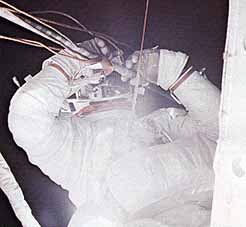 Joe Kerwin at work during the critical EVA task to repair Skylab. Photo Credit: NASAThe main problem, Conrad explained, was that a strip of metal had become wrapped across the solar array during the separation of the micrometeoroid shield. Its bolts had tangled themselves in the array and none of Weitz’s actions to cut the strap, even with the loppers, were having any effect. “Rather than cutting it across the short way, we were trying to cut along the long way,” Weitz said, “and didn’t have enough muscle with that thing, because it was six or eight feet out ahead of me and I was pulling on a line to try to do it.” The metal strap, ironically, was only a few centimetres wide, but it was riveted fast and Conrad knew they did not have a hope of breaking it using the tools in the command module.
Joe Kerwin at work during the critical EVA task to repair Skylab. Photo Credit: NASAThe main problem, Conrad explained, was that a strip of metal had become wrapped across the solar array during the separation of the micrometeoroid shield. Its bolts had tangled themselves in the array and none of Weitz’s actions to cut the strap, even with the loppers, were having any effect. “Rather than cutting it across the short way, we were trying to cut along the long way,” Weitz said, “and didn’t have enough muscle with that thing, because it was six or eight feet out ahead of me and I was pulling on a line to try to do it.” The metal strap, ironically, was only a few centimetres wide, but it was riveted fast and Conrad knew they did not have a hope of breaking it using the tools in the command module.
The attempt was scrapped and, after 40 minutes, the astronauts were instructed to close the hatch and re-dock with Skylab. Even this proved easier said than done: getting the pole, loppers, and shepherd’s crook back inside in a safe and speedy manner led to an inadvertent thump to Conrad’s helmet and an accidental kick to Kerwin. The capcom’s advice to modify their language again fell on deaf ears, as a few more “unscientific” words were uttered. Prolonged solar exposure had already caused Skylab’s outer skin to blister, as evidenced by this image from Pete Conrad’s mission. The scientific airlock aperture through which the parasol was extended is clearly visible. Photo Credit: NASAOn their first docking attempt, the probe did not engage with the drogue and no fewer than three further tries were also fruitless. “Pete gave Weitz the controls,” Nancy continued, “depressurised the command module, and opened the tunnel hatch. He and Joe dove head-first into the bank of circuits and gizmos, Pete cussing a blue streak as he sorted through wires, cutting and splicing like a pissed-off Maytag repairman trying to get a dryer to work again.” Weitz then set about rewiring in the right-hand equipment bay, removing the electrical inter-lock which prevented the main latches from actuating until the capture latches were secure. After an hour or so of re-routing and connecting wires, bypassing electrical relays for the capture latches on the tip of the probe, skinning knuckles—and another bout of undesirable vocabulary—Conrad used the service module’s thrusters to bring the two collars into direct contact, triggering a dozen capture latches in a cacophony like machine gunfire.
Prolonged solar exposure had already caused Skylab’s outer skin to blister, as evidenced by this image from Pete Conrad’s mission. The scientific airlock aperture through which the parasol was extended is clearly visible. Photo Credit: NASAOn their first docking attempt, the probe did not engage with the drogue and no fewer than three further tries were also fruitless. “Pete gave Weitz the controls,” Nancy continued, “depressurised the command module, and opened the tunnel hatch. He and Joe dove head-first into the bank of circuits and gizmos, Pete cussing a blue streak as he sorted through wires, cutting and splicing like a pissed-off Maytag repairman trying to get a dryer to work again.” Weitz then set about rewiring in the right-hand equipment bay, removing the electrical inter-lock which prevented the main latches from actuating until the capture latches were secure. After an hour or so of re-routing and connecting wires, bypassing electrical relays for the capture latches on the tip of the probe, skinning knuckles—and another bout of undesirable vocabulary—Conrad used the service module’s thrusters to bring the two collars into direct contact, triggering a dozen capture latches in a cacophony like machine gunfire.
They were at Skylab to stay.
In their oral histories, both Kerwin and Weitz paid tribute to a conversation with their rendezvous instructor, Jake Smith, in February 1973, in which the minutiae of how to accomplish this kind of “backup docking procedure”—which wires to cut and which to splice together—had been explored. Had it failed, there was a very real possibility that the mission would have ended. Now, though, with Apollo safely docked, an ecstatic Mission Control were able to advise the crew to grab a bite to eat and some sleep before entering Skylab the following morning. Their first day in space had been a long one—more than 22 hours, prompting Paul Weitz to quip that “union rules wouldn’t allow us to work that long anymore!” Surprisingly, neither of the rookies had gotten sick. Joe Kerwin had taken a pill shortly after reaching orbit, determined that he would not throw up and would not screw up the mission, but both he and Weitz adapted well to the weightless environment. Making his fourth space mission, Pete Conrad had no problems whatsoever.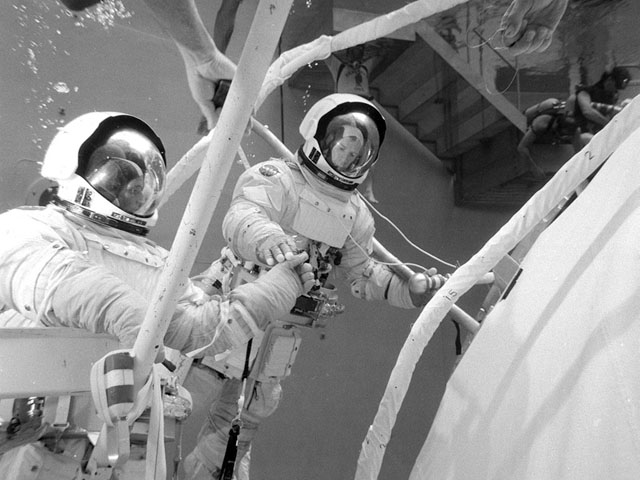 In the hectic ten days between the launch of Skylab and the launch of Pete Conrad’s crew, NASA and its contractors rose spectacularly to one of the greatest challenges in their history. In the water tank at the Marshall Space Flight Center, astronauts Rusty Schweickart and Ed Gibson practice repair techniques. Photo Credit: NASANext morning, the crew opened the hatch and Weitz, as the systems specialist, was the first to enter Skylab. Pressure checks and air sampling gave the atmosphere a clean bill of health. The multiple docking adaptor and airlock were cool, at just 13 degrees Celsius, but all three men knew that the unprotected interior of the station would be hotter and less comfortable. Conrad and Weitz stripped “down to our skivvies” and opened the hatch into the darkened workshop to deploy the parasol through the scientific airlock. “It didn’t take very long until we figured out why people in the Sahara Desert wear a lot of loose clothing,” reflected Weitz, “because soon we had long trousers on and shirts and jackets and hats and gloves and the whole thing.” The temperature was 55 degrees Celsius (131 degrees Fahrenheit)—“rather warm,” the two men noted—and although there was no evidence of toxic gas and the air was safe to breathe, Skylab’s humidity was low and they could only remain inside the stifling oven for 15 minutes at a time. Periodically, they had to retreat back to the relative comfort of the multiple docking adaptor for a breather.
In the hectic ten days between the launch of Skylab and the launch of Pete Conrad’s crew, NASA and its contractors rose spectacularly to one of the greatest challenges in their history. In the water tank at the Marshall Space Flight Center, astronauts Rusty Schweickart and Ed Gibson practice repair techniques. Photo Credit: NASANext morning, the crew opened the hatch and Weitz, as the systems specialist, was the first to enter Skylab. Pressure checks and air sampling gave the atmosphere a clean bill of health. The multiple docking adaptor and airlock were cool, at just 13 degrees Celsius, but all three men knew that the unprotected interior of the station would be hotter and less comfortable. Conrad and Weitz stripped “down to our skivvies” and opened the hatch into the darkened workshop to deploy the parasol through the scientific airlock. “It didn’t take very long until we figured out why people in the Sahara Desert wear a lot of loose clothing,” reflected Weitz, “because soon we had long trousers on and shirts and jackets and hats and gloves and the whole thing.” The temperature was 55 degrees Celsius (131 degrees Fahrenheit)—“rather warm,” the two men noted—and although there was no evidence of toxic gas and the air was safe to breathe, Skylab’s humidity was low and they could only remain inside the stifling oven for 15 minutes at a time. Periodically, they had to retreat back to the relative comfort of the multiple docking adaptor for a breather.
At length, the parasol was assembled and its rods were threaded through the aperture of the scientific airlock into vacuum. Next, the parasol emerged, folding out like a big patio umbrella. However, one of its four folded arms did not swing out properly and Kerwin, watching from inside the command module, expressed dismay when he saw it had only deployed to cover two-thirds of its required area. “It’s not laid out the way it’s supposed to be,” a dejected Conrad told Mission Control. The parasol was askew and crinkled in places. Nevertheless, Houston assured the astronauts that the wrinkles had probably set in during the coldness of the lengthy deployment, which took place during orbital “night-time” and, as the material heated up in sunlight, it would spread out fully.